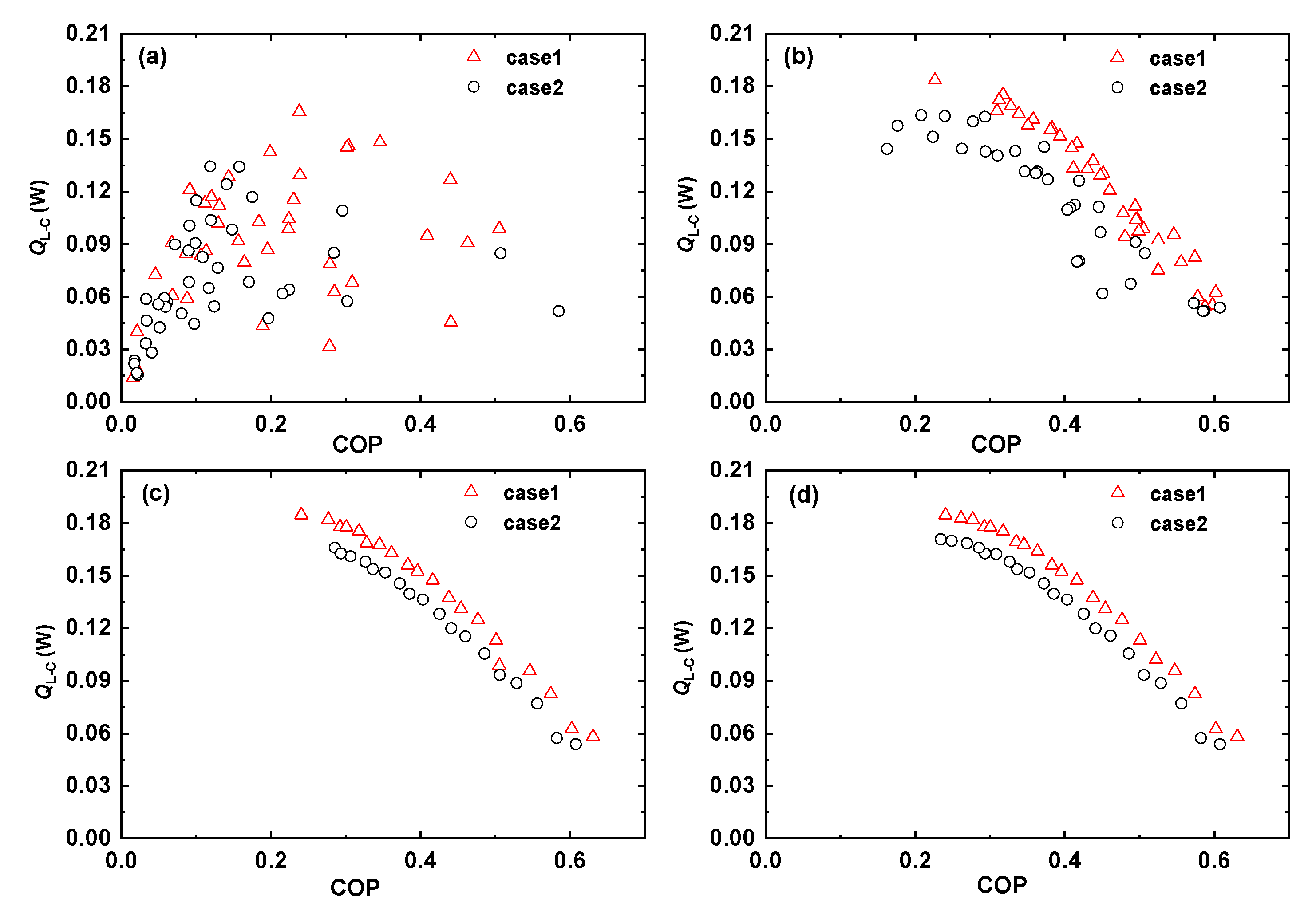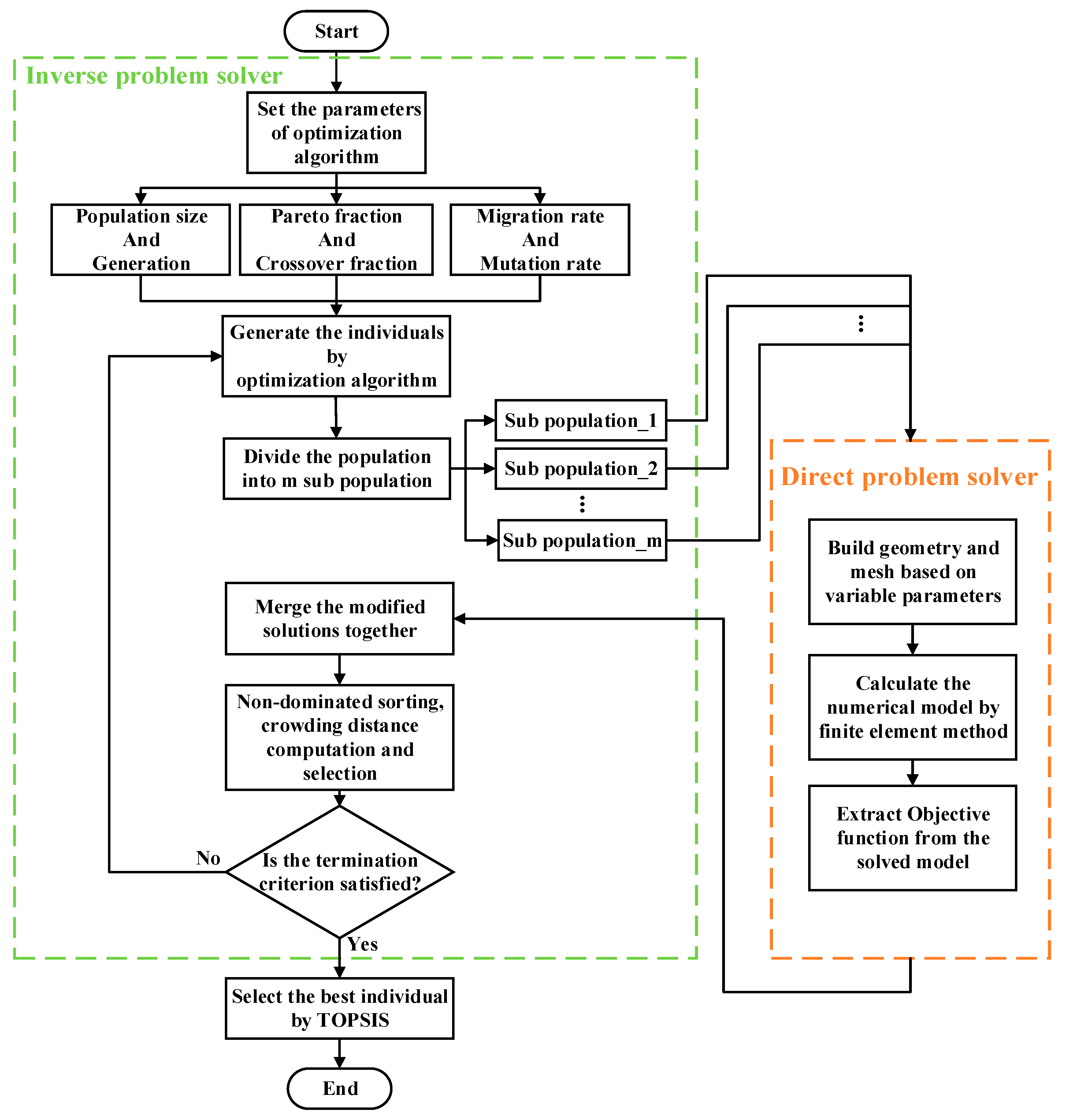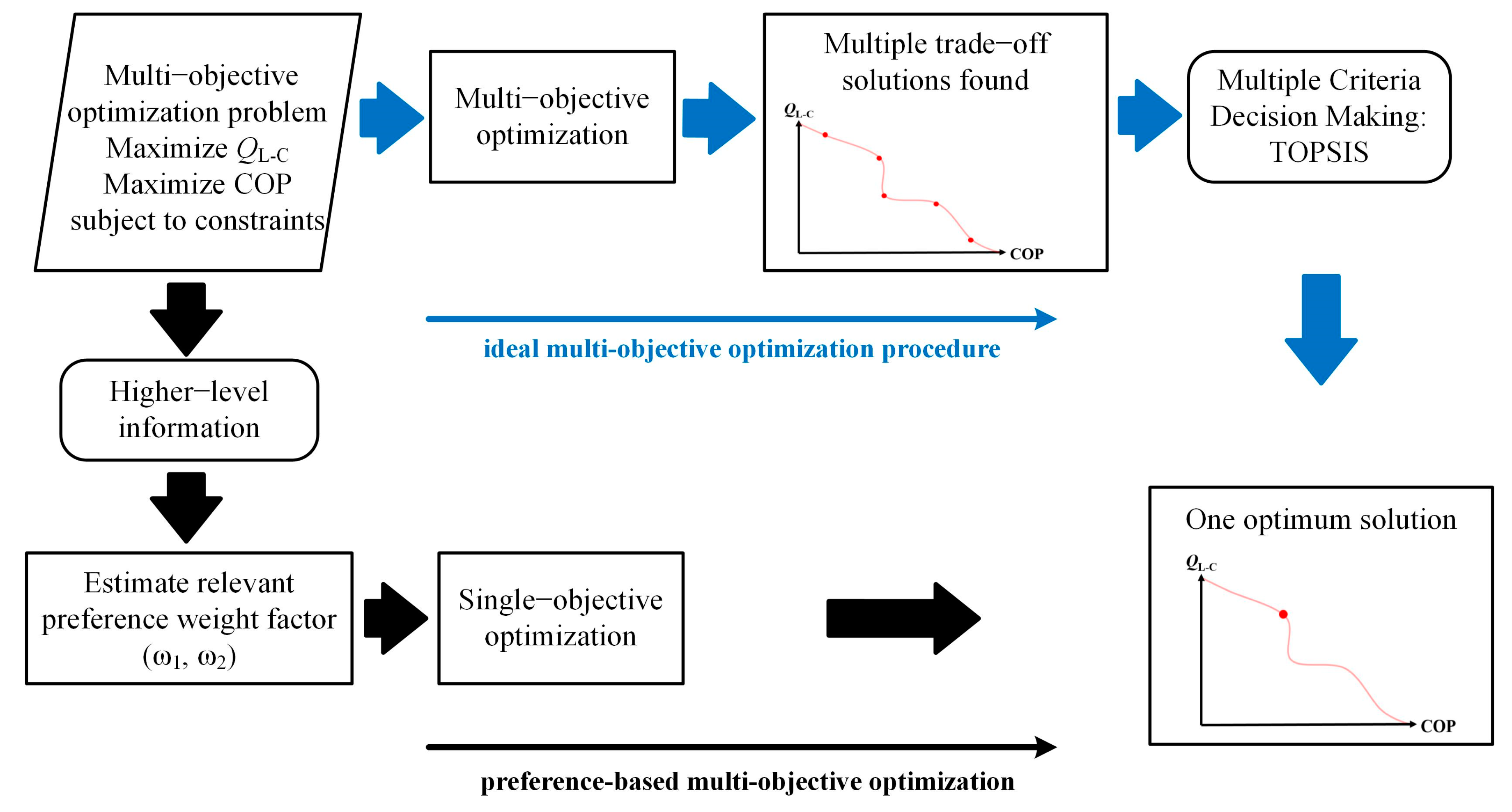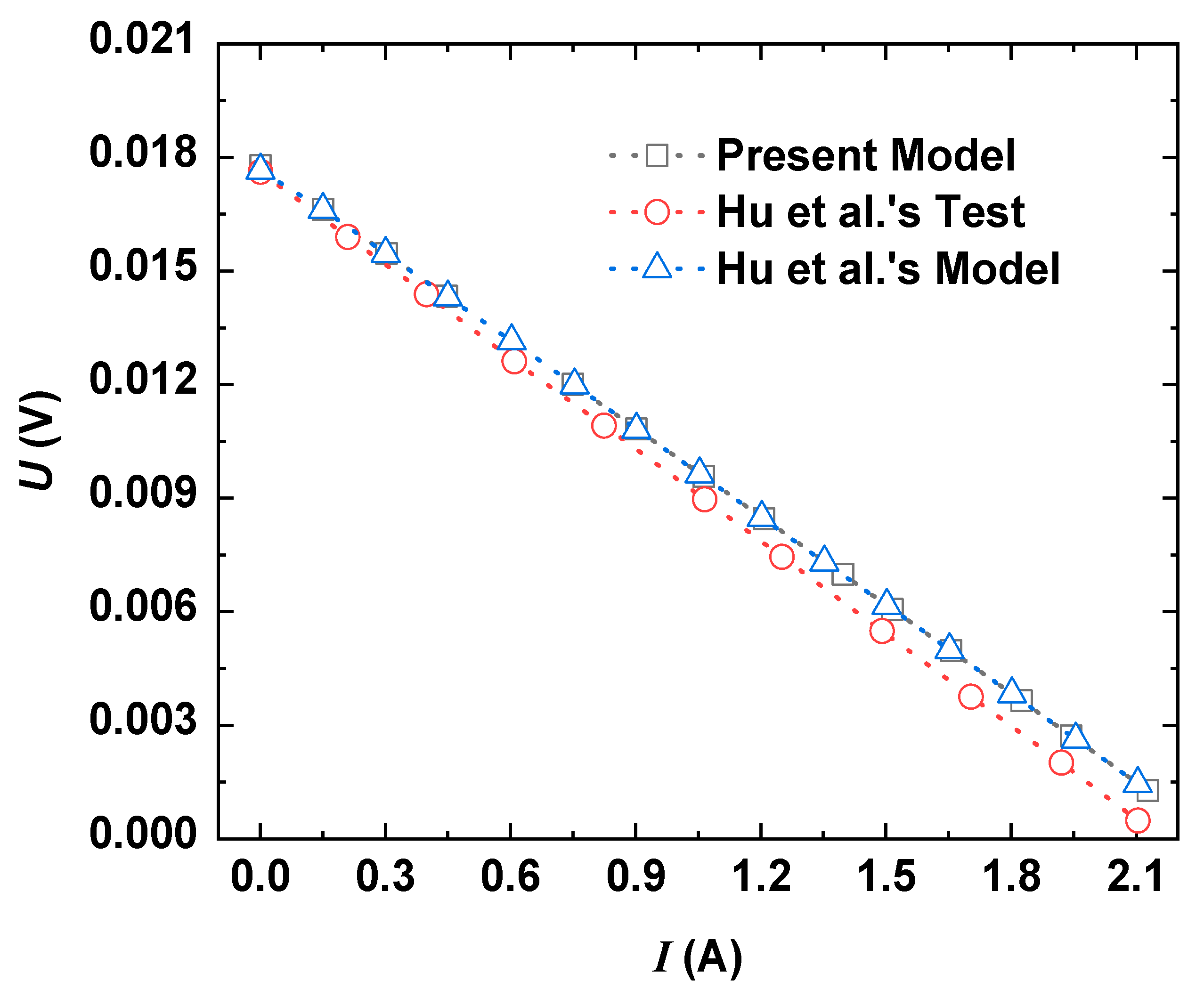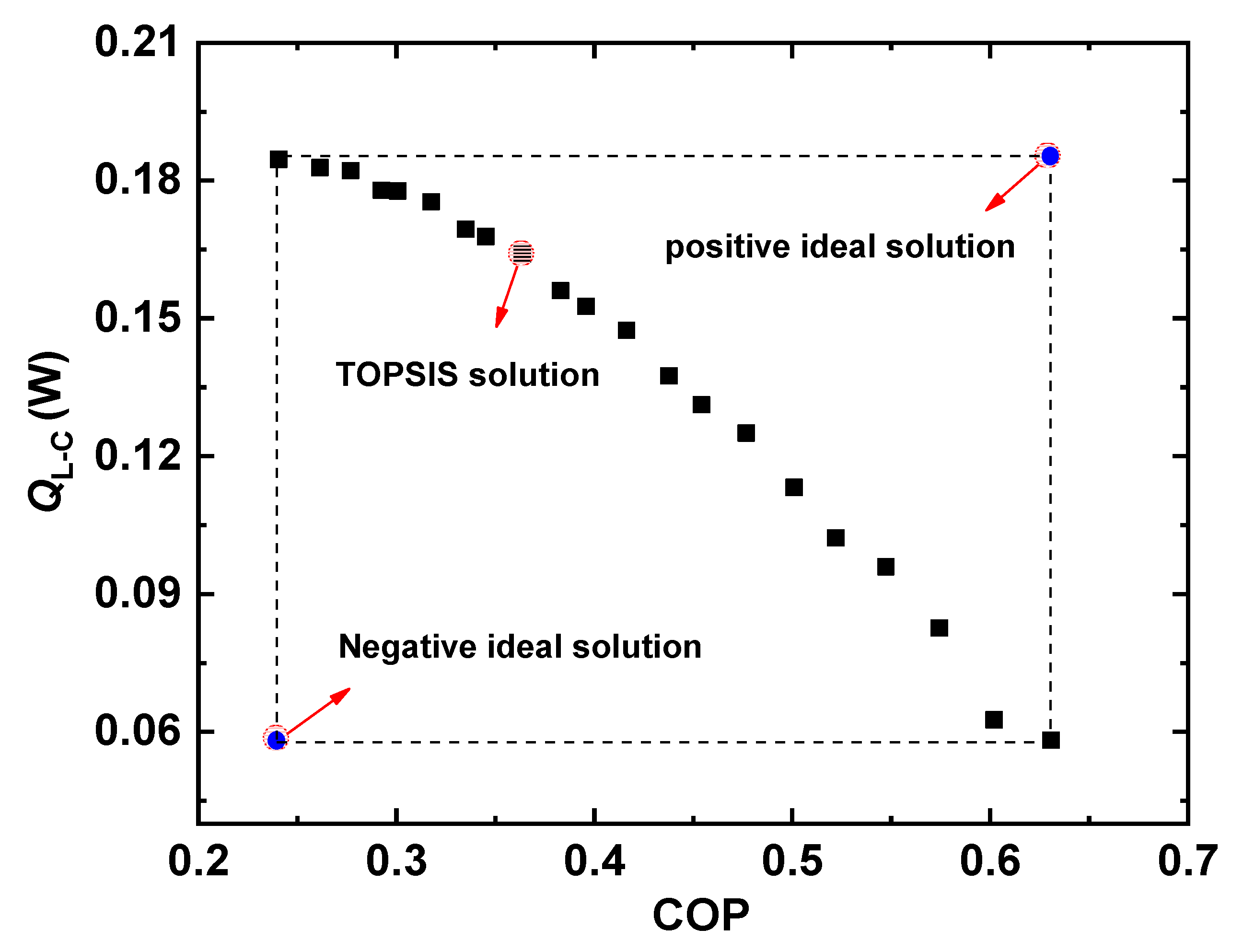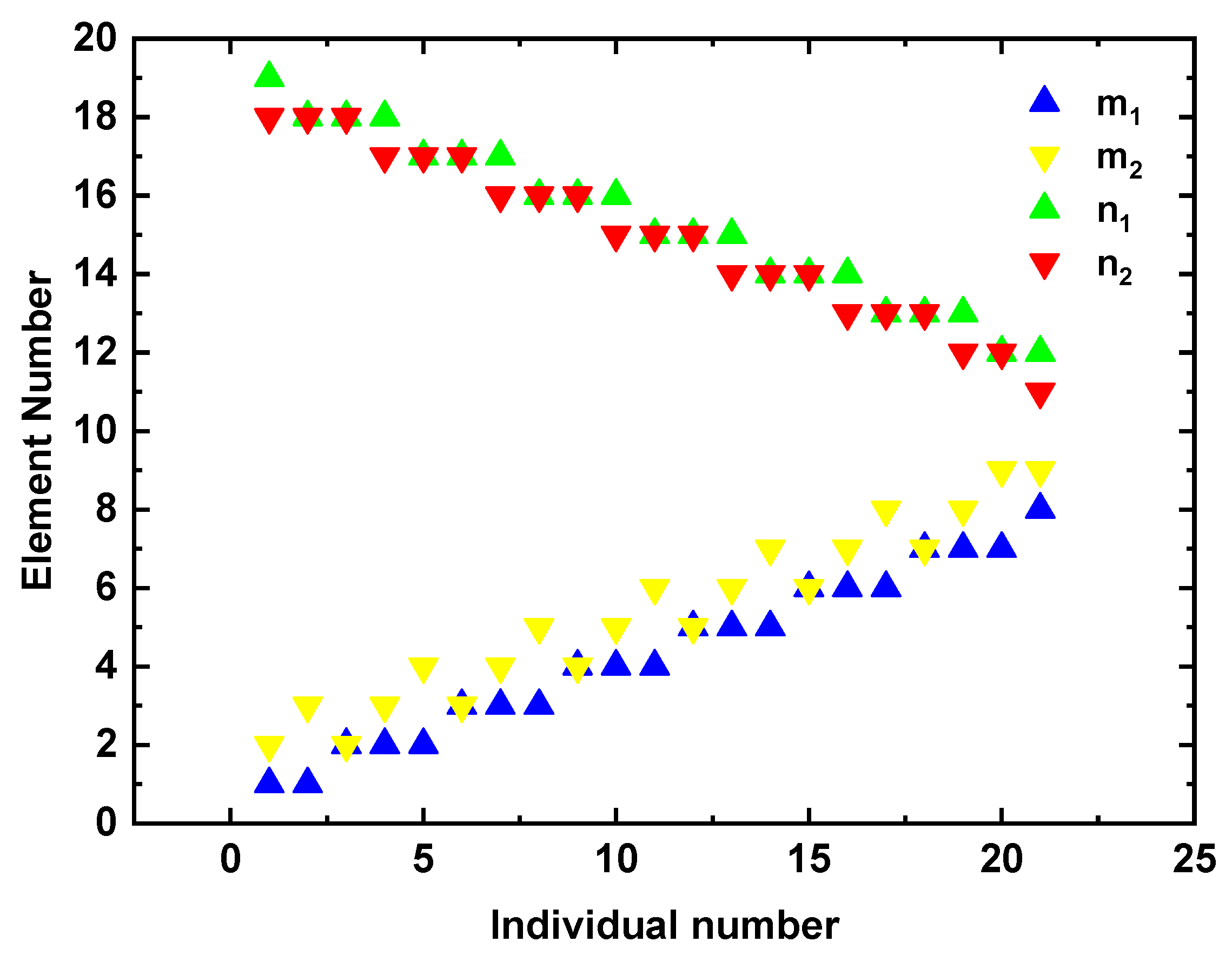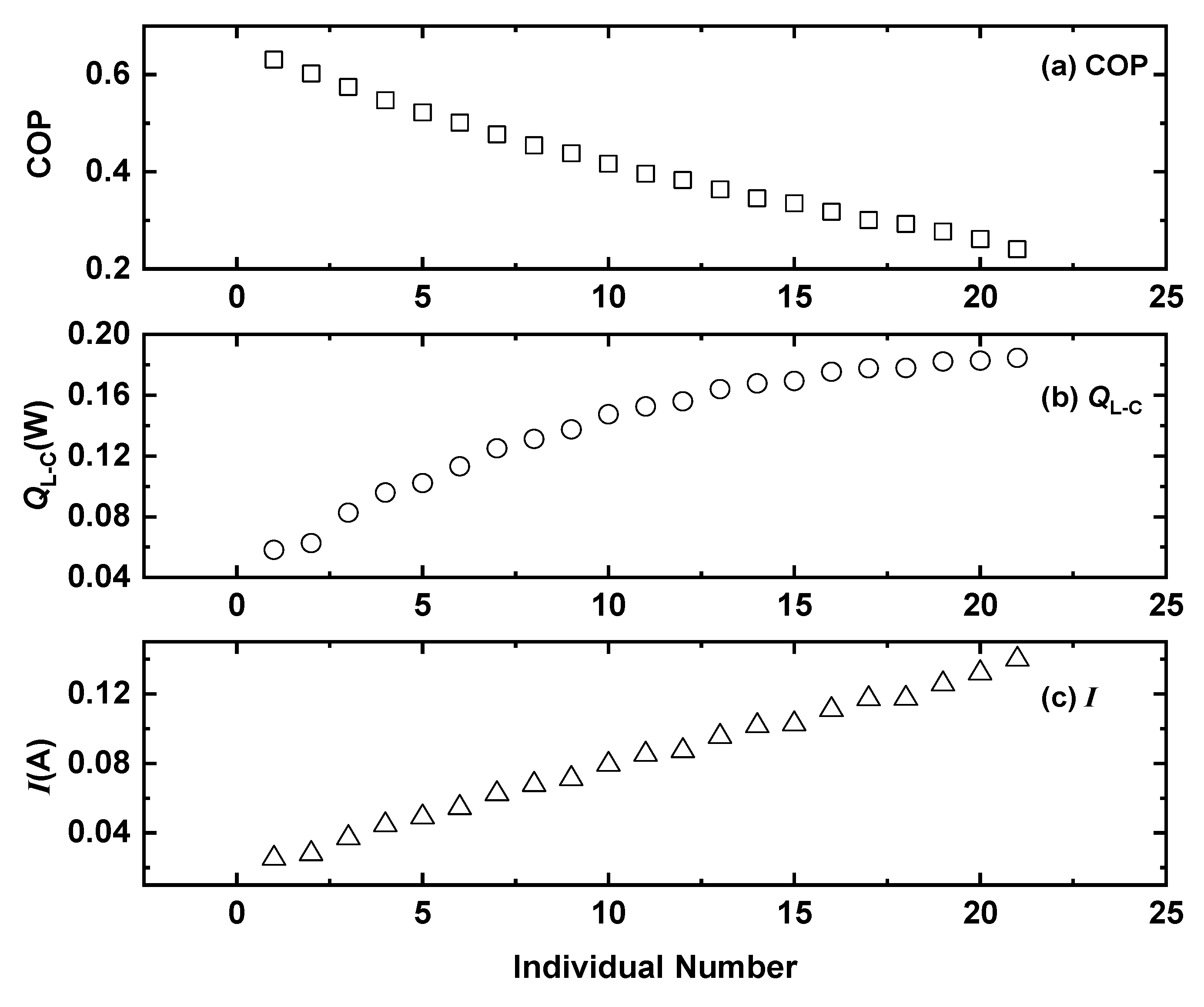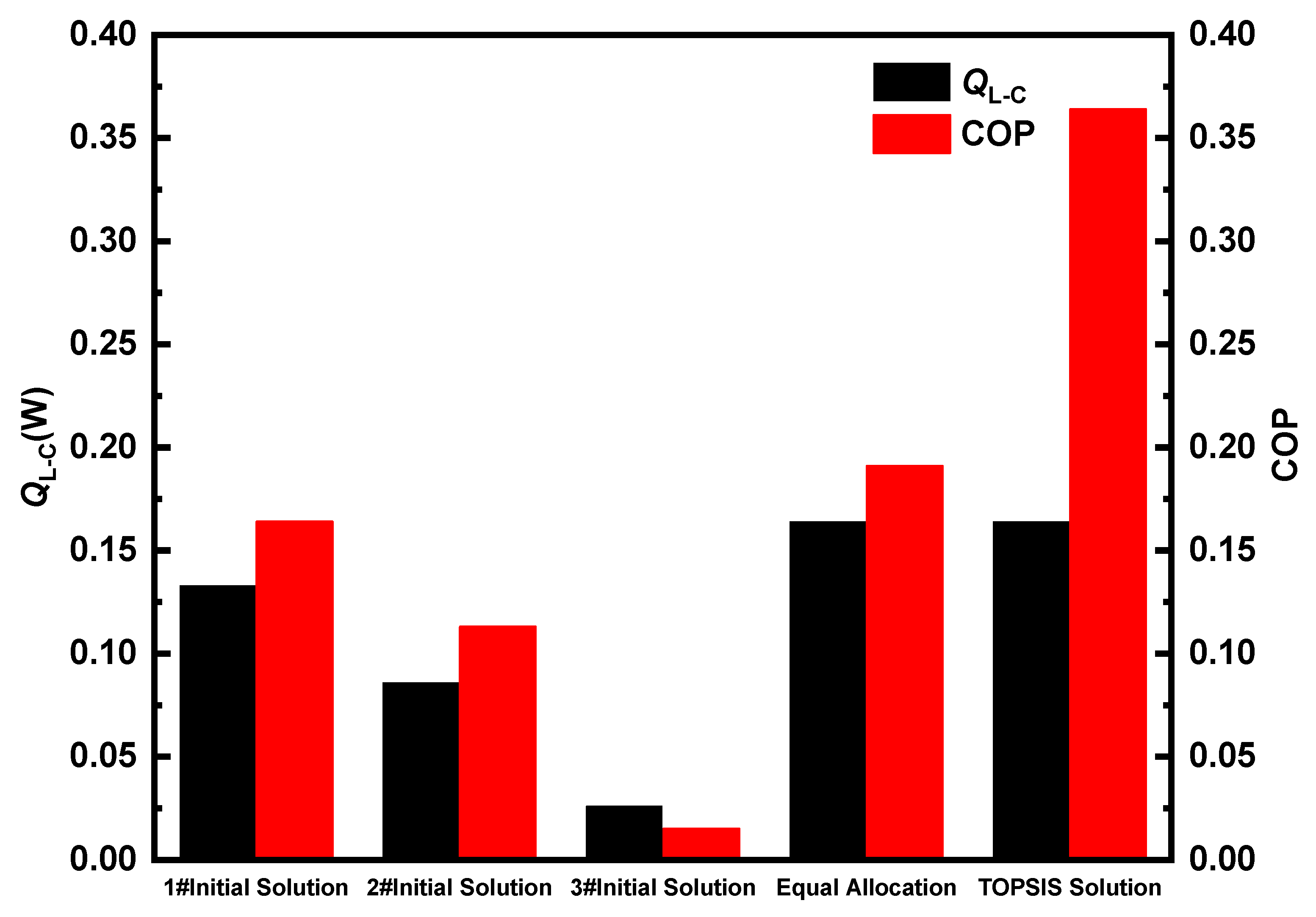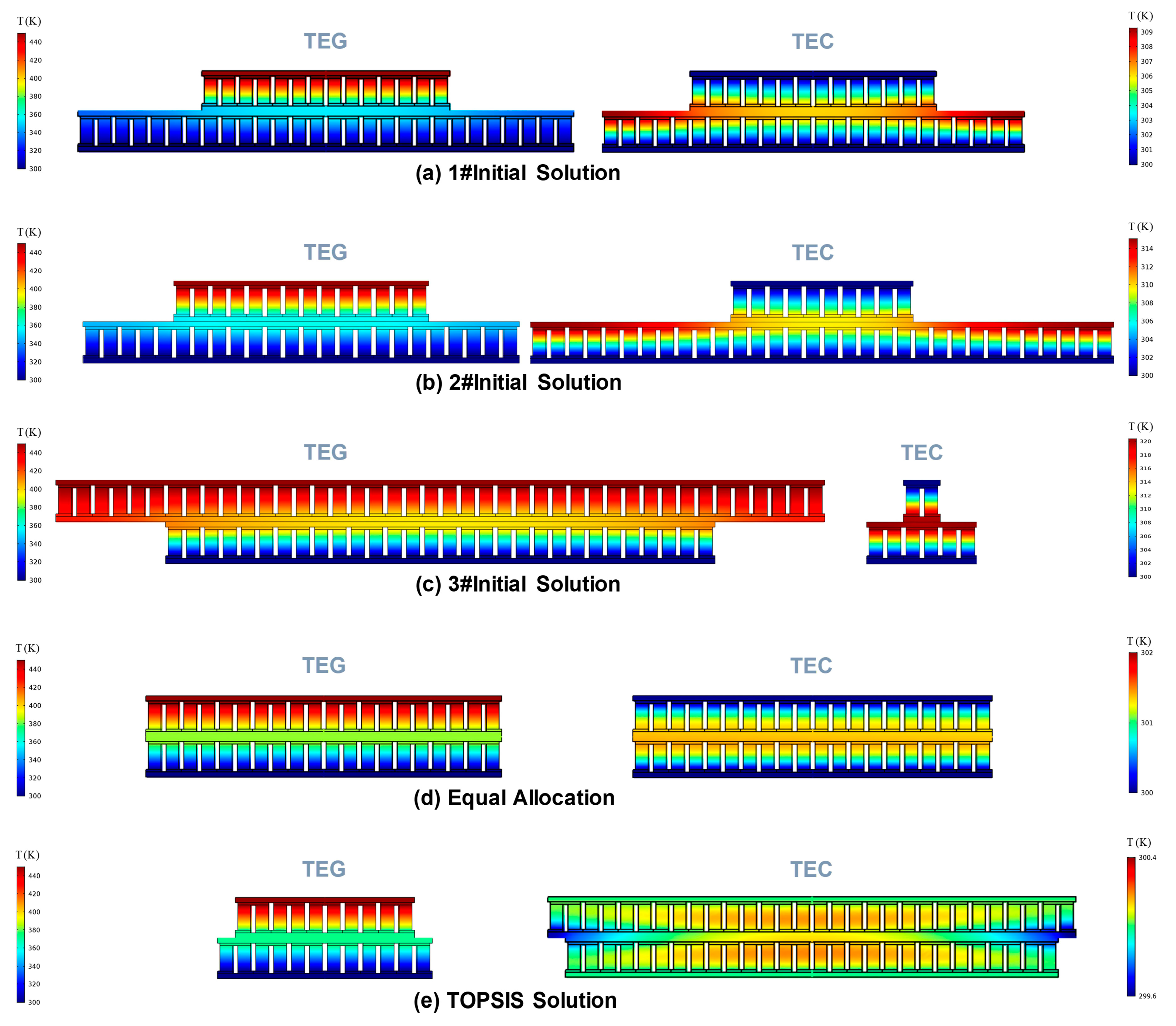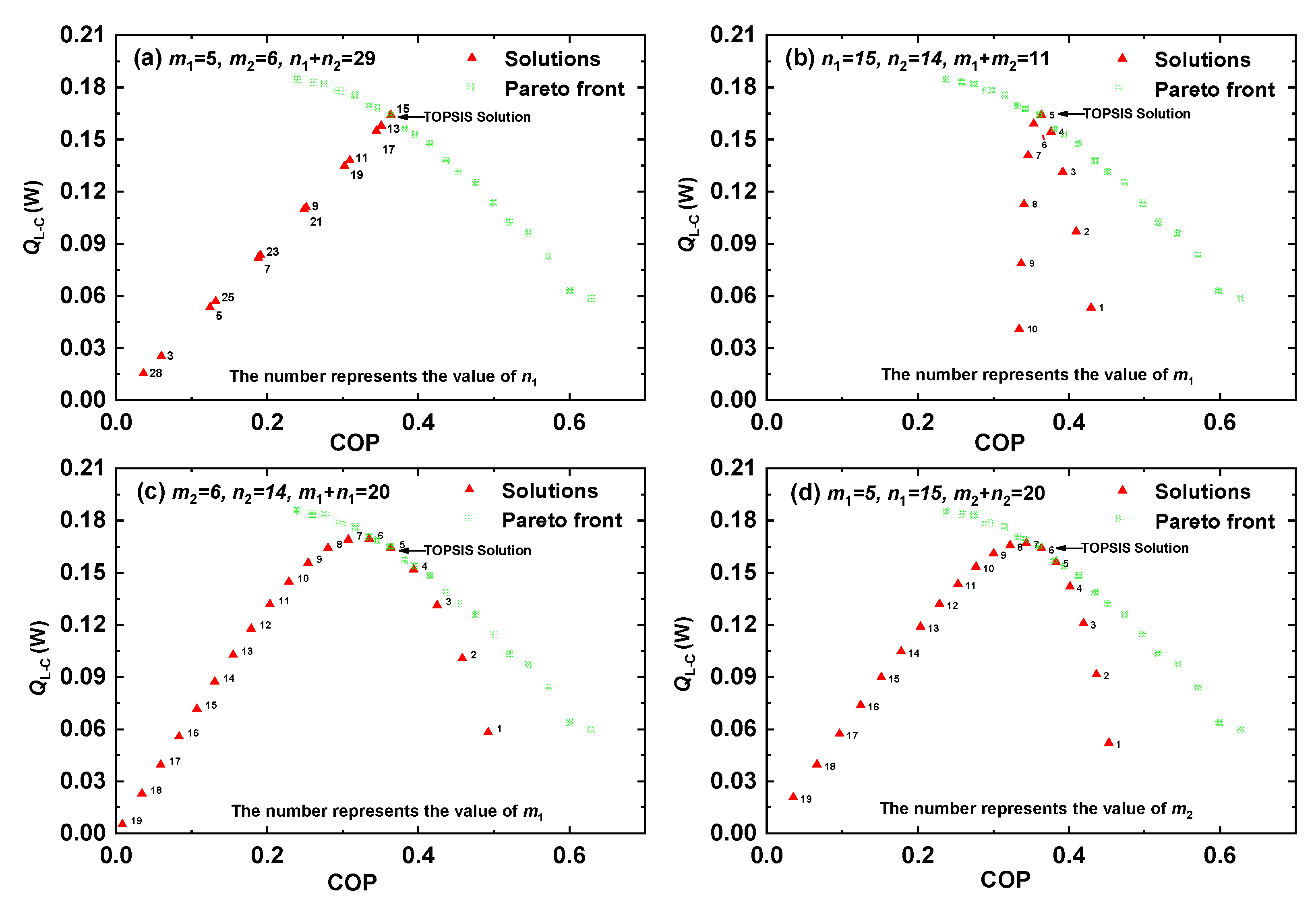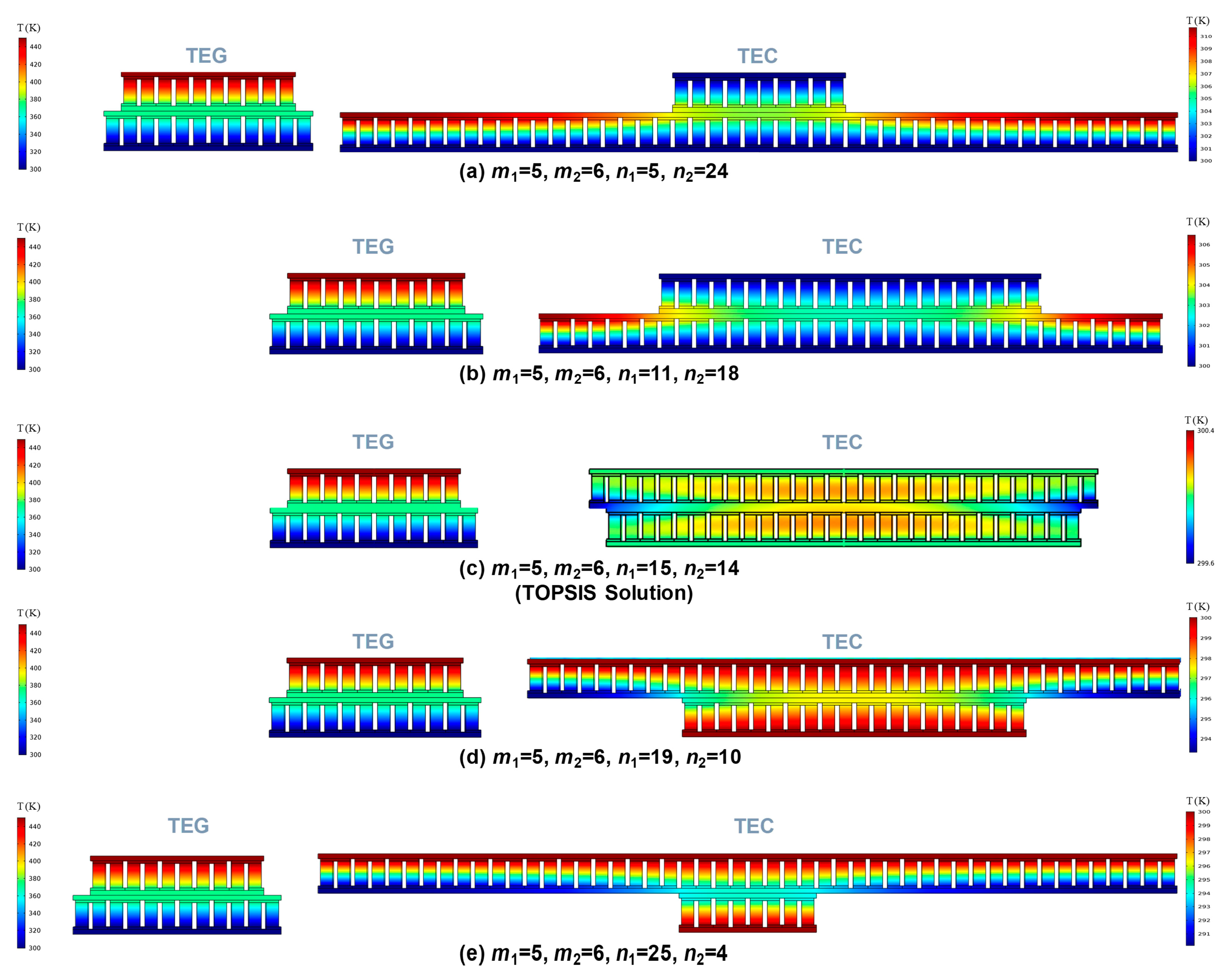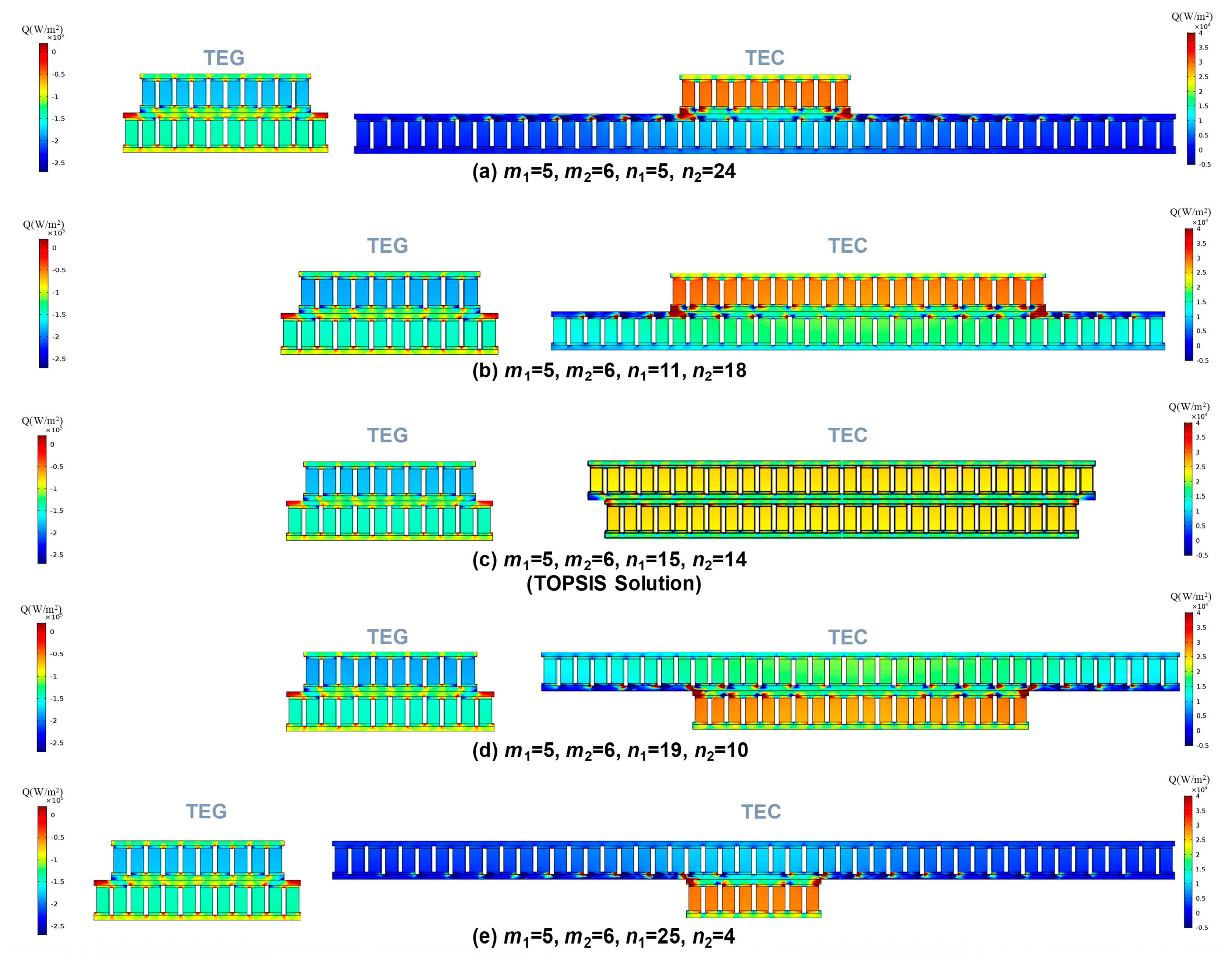4.2. Optimization Results
Figure 7 shows the optimization evolution progress. The first, fourth, tenth and eightieth generations are present in
Figure 6a–d, respectively. It proves that the solution converges at the tenth generation. To get a more accurate solution set, the solutions of the eightieth generation was selected in the present study. It should be indicated that, to ensure the trade-off solutions over the Pareto front are independent of the initial variable values randomly generated at the begin of the running, three sets of populations were determined. The results show that they are converted into a single Pareto front (see in
Figure 7d). This strongly justifies the effectiveness of the simulated results.
Figure 8 shows the Pareto front after multi-objective optimization, where the solutions are shown non-dominated. In the optimization process,
QL-C ranges from 0.06 to 0.18 and COP increases from 0.24 to 0.63. After determining the positive ideal solution (
QL-C = 0.18 and COP = 0.63) and negative ideal solution (
QL-C = 0.06 and COP = 0.24), the TOPSIS optimal results can be obtained at
QL-C = 0.16 and COP = 0.36, respectively. The value of the corresponding variables of
m1,
m2,
n1, and
n2 are 5, 6, 15, and 14 respectively. The value of search variables and performance metrics corresponding to each individual over the Pareto front for the improved CTE system is listed in
Table A4 from
Appendix C.
As indicated in the temperature boundary condition section, the simulations with
TH-C −
TL-C = 20 K is more practical with a view to commercial application. The results of this case are shown in
Appendix B. It should be noted here that the thermal conductivity of the ceramic plate is set as Equation (7) because temperature-dependent property is more practical.
Table A1 lists the value of search variables of
n1,
n2,
m1, and
m2 and performance metrics for the improved CTE system. The temperature profiles of five different allocation design with different sets of
n1,
n2,
m1, and
m2 are shown in
Figure A2. It is found that the optimal design is reached with a ratio of elements number between stages greater than 1, which is consistent with the results reported by Xuan et al. [
50].
Figure 9 illustrates the optimized element number assigned to each stage for each alternative solution along the Pareto front. It can be found that for each Pareto solution, number of elements of the TEC is always more than that of the TEG. The reason is that the TEC module must reject the extra Joule heat generated during TEC operation, which is not required in the TEG module. For TECs or TEGs considered individually, the element number for each stage shows less difference. Some solutions even show that each stage has the same element number either for the TEG or the TEC. When each stage shares a different element number, the number of elements in the top stage is larger than that of the lower stage for the TEC. On the contrary, the number of elements in the top stage is smaller than that in the lower stage for the TEG. These results are attributed to the fact that either for the TEC or the TEG, the heat rejection stage needs more elements to pump the extra Joule heat. The results reported by Xuan et al. [
50] are qualitatively consistent with above results, where it demonstrated that the maximum
QL-C (as well as the optimum COP) is reached with a number ratio of elements between stages greater than 1.
Figure 10a–b show the optimized objective functions of
QL-C and COP in the Pareto-optimal solution set. As the alternative solution varies,
QL-C increases from 0.06 to 0.18 and the corresponding COP decreases from 0.63 to 0.24, respectively. In addition, the variation of current is another indicator to evaluate the performance of the device. From
Figure 10c, it can be concluded that the current increases from 0.03 A to 0.14 A over the Pareto front. This means more Joule heat will be generated, which enhances the load for pumping heat from the cold end. The element number allocation shown in
Figure 9 can verify these results. The increased current accompanies more thermoelectric elements assigned to the TEG. The increased current can enhance
QL-C; however, the number allocated to the TEC module are also decreased which deteriorates
QL-C. There exists a trade-off between the above two factors to determine the final
QL-C. The enhanced
QL-C with increasing current demonstrates that the effect of electric current to increase
QL-C is stronger.
To verify the advantage of the optimized design, reference structure should be defined for performance comparison. NSGA-II algorithm begins with an initialized generation comprised of a collection of individuals generated randomly, any one of these individuals can be marked as an initial structure. As the optimization procedure evolves, the population searches fitter and fitter solutions by new generations and eventually converges to a set of Pareto-optimal solutions. Based on this principle, without the knowledge of how to determine the relevant values of
m1,
m2,
n1, and
n2 to design a CTE with optimal performance, values randomly specified as
m1,
m2,
n1, and
n2 seem to be an intuitive method. Hence, the initial structure randomly generated in the first generation can be marked as a benchmark to compare. To ensure the reliability of the reference structure, the three randomly generated initial structures corresponding to populations 1#, 2#, and 3# shown in
Figure 7 are all selected, which are marked as 1# initial solution, 2# initial solution, and 3# initial solution, respectively. It should be noted that, another case that can also be intuitively selected as reference is the equal allocation to
m1,
m2,
n1, and
n2. Thus, this case is also selected as the benchmark to compare.
The values of the objective functions compared between the three initial solutions and the optimized design selected by TOPSIS are shown in
Figure 11. The equal allocation design is also compared in the figure. From
Table 4, it is worth mentioning that, after optimization, the cooling capacity is improved by 23.3%, 90.2%, and 551.7%, respectively, compared with 1# initial solution, 2# initial solution, and 3# initial solution. COP is increased by 122.0%, 221.1%, and 2377.4%, respectively, compared with 1# initial solution, 2# initial solution, and 3# initial solution. Also, it can be found that the optimized design has increased COP by 90.6% at the expense of 8.1% cooling capacity compared to equal allocation design. In terms of comprehensive trade-offs between cooling capacity and COP, the optimized design selected by TOPSIS is superior to both initial design and equal allocation design structure.
To explain the underline physics of the improved performance for the optimized structure, the temperature profiles of the improved design is compared with the three initial solutions and the equal allocation design as shown in
Figure 12. It is found that the temperature difference is very large between the top and lower stages for both the TEG and the TEC module in the three initial solutions, which means the heat cannot transfer easily through the device due to the improper element number allocation. The heat is accumulated at the interface between the top and the lower stage in the TEC module. For the equal allocation design, although the heat transport is more uniform, there still exist heat accumulation. However, after optimization, appropriate element number ratio between the TEG and TEC as well as between the two stages for TEG and TEC eliminate the heat accumulated at the stage interfaces, which enhance the entire performance of the CTE. This mechanism is consistent with the previous results reported in [
51].
To further elucidate the effect of variation of
m1,
m2,
n1, and
n2 on the performance of the CTE device, analysis from the point of view of temperature distribution and heat flux is present in this section. the results are beneficial to optimize the geometry of the device. It is believed that when the element number allocated to TEG is fixed, different number ratio between the top and the lower stage of TEC will influence the CTE performance, and vice versa when the element number allocated to TEC is fixed. Also, when the element number allocated to the two lower stages of CTE is fixed, different number ratio between the TEG module and the TEC module for the two top stages of CTE will influence the CTE performance, and vice versa when the element number allocated to the two top stages of CTE is fixed. Accordingly, four sets of cases corresponding to above conditions are shown in
Figure 13a–d, respectively, in which the variables of
n1,
n2,
m1, and
m2 are changed, respectively. It is interestingly found that, for each variable, there exists an optimal value, which corresponding to the optimal solution selected by TOPSIS in the optimization procedure.
The heat transport equilibrium between the TEG module and the TEC module or between the top stage and the lower stage of the CTE is the key point to determine the device performance. To justify this hypothesis, we select the cases shown in
Figure 13a as representatives to analyze, where the structures with
n1 = 5, 11, 15, 19, and 25 are chosen. When the elements to the top and the lower stage of TEC are re-allocated, the circuit load connected to the TEG is changed, which may cause the generated current decrease or increase. Then the Joule heat and
QL-C curve vary with current. Besides, the re-allocated elements also leads to the heat load to the top and the lower stage changed, breaking the heat transport equilibrium in the device. The updated cooling capacity of the top and the lower stage influence
QL-C. Above factors together determine the final
QL-C. The temperature profiles and heat flux distributions are illustrated in
Figure 14 and
Figure 15, respectively. It is found that, as
n1, increases from 3 to 15, the heat accumulated at the interface is alleviated, and the heat flux is also distributed more uniformly. As
n1 further increases from 15 to 25, the heat flux distribution and the resultant temperature profile is again deteriorated. The change of heat transport equilibrium influences the
QL-C of the TEC and the
QH-G of the TEG, which resultantly causes the COP variation.
